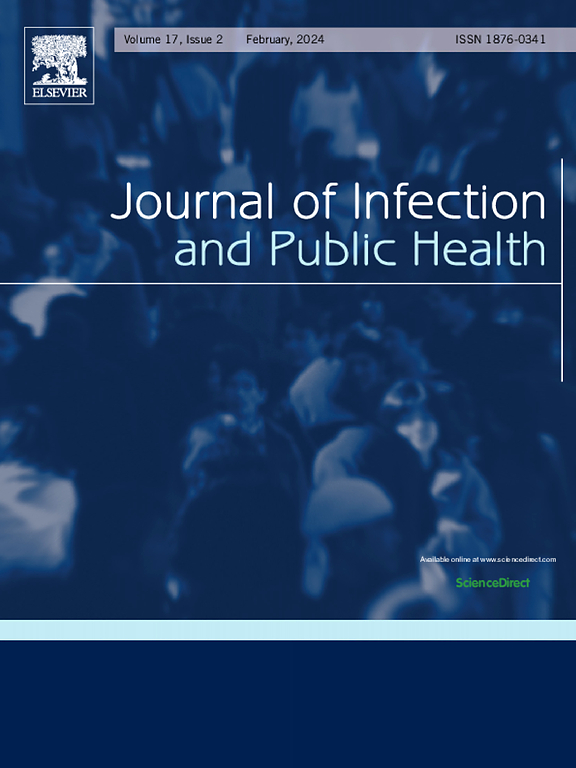Changes in mortality due to respiratory diseases around the COVID-19 pandemic: A multi-national comparative study
IF 4
3区 医学
Q1 INFECTIOUS DISEASES
引用次数: 0
Abstract
Background
Various preventive measures in the coronavirus disease-2019 (COVID-19) pandemic could disrupt the transmission of respiratory pathogens and affect the epidemiology of other respiratory diseases. The aim was to compare mortality due to respiratory diseases before and during the COVID-19 pandemic in the United States and South Korea.
Methods
Mortality due to respiratory diseases was investigated between December 2017 and December 2021 using two nationwide datasets from the United States and South Korea. Respiratory diseases were categorized into pneumonia, influenza, chronic lower respiratory diseases, and upper respiratory infections, defined by ICD-10 codes. The terms ‘before the COVID-19 pandemic’ and ‘during the COVID-19 pandemic’ refer to the intervals from December 2017 to February 2020 and from March 2020 to December 2021, respectively.
Results
Mortality due to respiratory diseases decreased during the COVID-19 pandemic in the United States and South Korea, except for upper respiratory infection. Although a sharp increase in mortality was noted in the winter compared with other seasons before the COVID-19 pandemic, the winter mortality peaks for pneumonia, influenza, and chronic lower respiratory diseases were reduced during the COVID-19 pandemic. In the United States, winter mortality due to pneumonia declined from 17,167 deaths in 2017–2018 to 11,745 deaths in 2020–2021. Similarly, influenza mortality decreased from 9676 to 165 deaths, and deaths from chronic lower respiratory diseases declined from 47,905 to 36,674. South Korea showed a trend comparable to that of the United States. These changes were not observed in upper respiratory infections. Trend of annual mortality for each respiratory disease was significantly different before and during the COVID-19 pandemic, except for influenza in the under-70 age group and upper respiratory infections in all age groups.
Conclusions
The COVID-19 pandemic affected the epidemiology of respiratory diseases. The findings suggest that various preventive measures in the COVID-19 pandemic might have contributed to changes in their epidemiology.
COVID-19大流行期间呼吸系统疾病死亡率的变化:一项多国比较研究
背景2019冠状病毒病(COVID-19)大流行的各种预防措施可能会破坏呼吸道病原体的传播,并影响其他呼吸道疾病的流行病学。目的是比较美国和韩国在COVID-19大流行之前和期间因呼吸道疾病导致的死亡率。方法使用来自美国和韩国的两个全国性数据集,调查2017年12月至2021年12月期间因呼吸系统疾病导致的死亡率。根据ICD-10编码,呼吸道疾病分为肺炎、流感、慢性下呼吸道疾病和上呼吸道感染。“2019冠状病毒病大流行之前”和“2019冠状病毒病大流行期间”分别指2017年12月至2020年2月和2020年3月至2021年12月这段时间。结果2019冠状病毒病大流行期间,除上呼吸道感染外,美国和韩国呼吸道疾病死亡率均有所下降。尽管与COVID-19大流行前的其他季节相比,冬季死亡率急剧上升,但在COVID-19大流行期间,肺炎、流感和慢性下呼吸道疾病的冬季死亡率高峰有所降低。在美国,冬季肺炎死亡人数从2017-2018年的17167人下降到2020-2021年的11745人。同样,流感死亡人数从9676人减少到165人,慢性下呼吸道疾病死亡人数从47 905人减少到36 674人。韩国也呈现出与美国相当的趋势。这些变化在上呼吸道感染中未被观察到。除70岁以下年龄组的流感和所有年龄组的上呼吸道感染外,各呼吸道疾病的年死亡率在COVID-19大流行之前和期间的趋势存在显著差异。结论2019冠状病毒病疫情影响了呼吸道疾病的流行病学。研究结果表明,COVID-19大流行中的各种预防措施可能导致了其流行病学的变化。
本文章由计算机程序翻译,如有差异,请以英文原文为准。
求助全文
约1分钟内获得全文
求助全文
来源期刊

Journal of Infection and Public Health
PUBLIC, ENVIRONMENTAL & OCCUPATIONAL HEALTH -INFECTIOUS DISEASES
CiteScore
13.10
自引率
1.50%
发文量
203
审稿时长
96 days
期刊介绍:
The Journal of Infection and Public Health, first official journal of the Saudi Arabian Ministry of National Guard Health Affairs, King Saud Bin Abdulaziz University for Health Sciences and the Saudi Association for Public Health, aims to be the foremost scientific, peer-reviewed journal encompassing infection prevention and control, microbiology, infectious diseases, public health and the application of healthcare epidemiology to the evaluation of health outcomes. The point of view of the journal is that infection and public health are closely intertwined and that advances in one area will have positive consequences on the other.
The journal will be useful to all health professionals who are partners in the management of patients with communicable diseases, keeping them up to date. The journal is proud to have an international and diverse editorial board that will assist and facilitate the publication of articles that reflect a global view on infection control and public health, as well as emphasizing our focus on supporting the needs of public health practitioners.
It is our aim to improve healthcare by reducing risk of infection and related adverse outcomes by critical review, selection, and dissemination of new and relevant information in the field of infection control, public health and infectious diseases in all healthcare settings and the community.
 求助内容:
求助内容: 应助结果提醒方式:
应助结果提醒方式:


